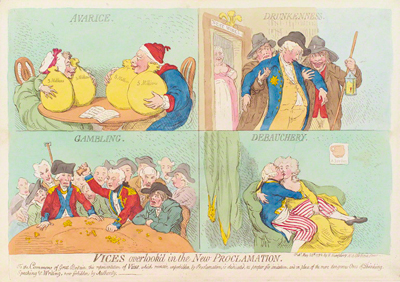Vices Overlook'd in the New Proclamation
The "New Proclamation" of Gillray's title refers to the Royal Proclamation Against Seditious Writings and Publications which had been "Given at our Court at the Queen's House" on May 21st and published in full by various newspapers over the next few days. It was in large part a response to the huge popularity of Thomas Paine's The Rights of Man which had been published in two parts—the first in March 1791, and the second in February 1792, and a growing fear that foreign powers were actively trying to "raise groundless jealousies and discontents in the minds of our faithful and loving subjects."
It was, at this point, framed as a personal exhortation to his people by the King, and submitted for consideration in the House of Commons. But it did contain the ominous injunction "to our Magistrates in and throughout our Kingdom. . .that they do make diligent inquiry, in order to discover the Authors and Printers of such wicked and seditious Writings."
To a satiric caricaturist like Gillray, however, this was a threat to both his person and livelihood, depending, as they did, upon the ability to exercise free speech. Gillray's response was swift and pointed: a direct attack against the hypocrisy of the King for pretending to moral authority in his kingdom while overlooking the well-known vices of himself and the most conspicuous members of his family.

© National Portrait Gallery, London
The subtitle of the print reads as follows:
To the Commons of Great Britain, this representation of Vices, which remain unforbidden by Proclamation, is dedicated, as proper for imitation, and in place of the more dangerous ones of Thinking, Speaking & Writing, now forbidden by Authority.
The print consists of four panels, each devoted to a different vice, and each one illustrated by a member of the royal family.
Avarice shows the King and Queen hugging sacks of money, repeating the claim of royal greed and hording made in previous Gillray prints such as A New Way to Pay the National Debt (1786) and The Introduction (1791). The account book open on the table before them inscribed "Account of Money at interest in Germany" recalls the similar charge made in An Angel, Gliding on a Sun Beam into Paradice that the Queen maintained a kind of private slush fund back in her home country.
Drunkeness shows the Prince of Wales identified by the star on his jacket and the three plumed feathers over the doorway being led away from a tavern/brothel in a drunken stupor. Much to the amusement of the night watchmen supporting him, the Prince has been obviously overcome by the strength of the "Neat" (uncut) wines sold there.
Gambling shows Frederick, Duke of York, who followed in his older brother's footsteps, with dice cup raised, addicted to gambling, and forever in debt.
Debauchery shows Prince William Henry, the Duke of Clarence, in a pose recalling Hogarth's A Rake's Progress, burnishing his reputation as a ladies' man, with his latest mistress, Mrs. Jordan, whose name, unfortunately was synonymous with a chamber pot.
Gillray had created two-panel caricatures, usually suggesting a before and after scenario: Minister In / Minister Out (1782) or The National Assembly Petrified. / The National Assembly Revivified (1791). This was his first use of a four-panel format.
Sources and Reading
- Commentary from the British Museum on Vices Overlook'd in the New Proclamation
- "Royal Proclamation Against Seditious Writings and Publications," Wikipedia
- "George III of the United Kingdom," Wikipedia
- "Charlotte of Mecklenburg-Strelitz," Wikipedia
- "George IV of the United Kingdom," Wikipedia
- "Prince Frederick, Duke of York and Albany," Wikipedia
- "William IV of the United Kingdom," Wikipedia
- Thomas Wright and R.H. Evans, Historical and Descriptive Account of the Caricatures of James Gillray #80
Comments & Corrections
NOTE: Comments and/or corrections are always appreciated. To make that easier, I have included a form below that you can use. I promise never to share any of the info provided without your express permission.